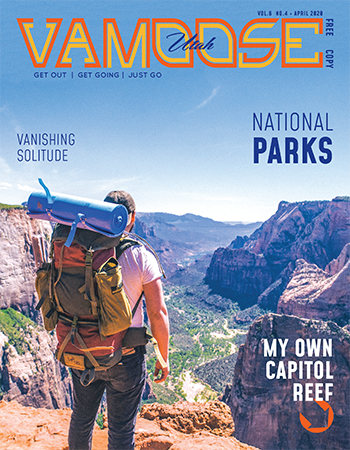Dig in to a favorite ice slab and gain some elevation
By Claire McArthur
Whether you need a break from ski resorts or are searching for a new winter passion, northern Utah abounds with possibilities for year-round outdoor adventure.
And for Carl Dec, owner of guiding company Red River Adventure, that cold-weather calling has been ice climbing for the past two decades.
“I think that it’s super compelling for me because it’s always different. Even the same routes form differently every year, and then there’s routes that don’t form for years,” says Dec. “I enjoy the chase.”
He and his guides have been leading ice climbing trips around Salt Lake City, including Little Cottonwood and Provo canyons, for just as long. Most of their clients have never ice climbed before—or any other surface.
“There’s been a ton of interest in the sport,” says Dec. “People come to Salt Lake to ski, and if you’re here for a week, they may not want to ski every day, and they are looking for some sort of activity to try. Ice climbing has become one of those options for folks.”
Preparing ice-climbing newbies is intensive, starting first with understanding the basics of staying warm when you’re spending a day outside against a slab of ice. Dec and his team go over the importance of layers for regulating your temperature and how to use crampons when walking on flat surfaces versus inclines.
Dec says it’s vital for novices to find an experienced mentor or guide to help them become familiar with the tools, techniques and dangers of ice climbing.
“There’s more objective hazard in ice and snow falling from above. It’s much more like climbing in the mountains than single-pitch rock climbing tends to be,” says Dec.
Similar to rock climbing, however, guides anchor a top rope, either from a permanent bolt in the rock or one attached using an ice screw. Climbers are fitted with helmets and harnessed in.
“We talk about the basics of the equipment, climber communication, how to swing the ice tools and how to swing your feet to use the crampons properly,” explains Dec. “And then, from there, we will let people climb, see what we have, and we’ll talk more about efficiency and climbing movement based on that.”

The thing about ice climbing that differs from rock climbing is there are holds just about everywhere.
—Carl Dec
Ice climbers wear crampons—metals spikes that protrude from the bottom and toe of the boot—which can be strapped onto existing boots or you can wear a pair with built-in crampons. They allow climbers to grab footholds as they ascend the ice, all while being supported by a belayer controlling the rope from below.
Wielding an ice tool is another important aspect of ice climbing. The two-sided ice tool has a pick on one side and a chisel-like tool on the other. The pick is swung into the ice to use as a grip as you hoist yourself up, while the chisel is designed to chop holds in the ice.
“The thing about ice climbing that differs from rock climbing is there are holds just about everywhere,” says Dec. “If you move your feet and swing your tools efficiently and well, you can make grips and footholds, but it’s the same basic body position that you use in rock climbing.”
The ice climbing season in northern Utah usually kicks off around Thanksgiving and ends early March, but this year “it’s safe to say that we’re in the midst of the worst ice climbing season in two decades,” laments Dec.
Many routes that are formed in November—either by frozen spring water or the melt-freeze cycle of snow—are not yet climbable in the new year.
Temperature, as one might imagine, is a huge concern. When it’s too cold, the ice becomes brittle and is at risk to break. While it’s much easier to climb when it’s warmer and the ice is softer, it also poses a risk of dislodging.
“So, you’re looking for the sweet spot where it’s not too cold and not too warm. Fifteen degrees right up to freezing,” says Dec.
Dec leads ice climbs all over northern Utah, from beginner ice climbs in Little Cottonwood Canyon to the five-pitch, 800-foot Stairway to Heaven in Provo Canyon. There’s something for all skill levels.
For beginners, Dec recommends renting gear before taking the plunge and purchasing your own. REI, Black Diamond, and university outdoor recreation programs are great options for renting gear as you get a feel for the sport.
“Remember to take care of yourself and enjoy the day. Ice climbing doesn’t have to be cold and miserable. If it’s done well, you can spend a great day outside,” Dec says. “And above all, be safe. Check the avalanche reports before you climb.”
Red River Adventures
1140 S Main, Moab
435-259-4046
RedRiverAdventures.com



